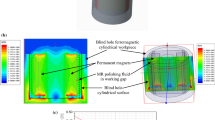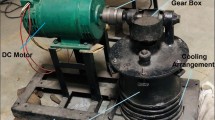Abstract
In metal forming processes, surface roughness plays a vital role in deciding the efficiency of the process. A rough surface results in more power loss and abrasion in dies and punches during metal forming operations. In the present work, the magnetorheological fluid-based finishing process is used to finish the industrial tube extrusion punch made of hardened H13 die steel material. A magnetorheological solid core rotating tool has been used in the process. Process parameters for AISI H13 steel have been optimized using response surface methodology. For the study of process parameters optimization, specimens in the form of pieces are prepared. These specimens maintain the same surface roughness and hardness as that of the industrial extrusion punch. The effect of various process parameters on the percentage change in average surface roughness of H13 die steel is analyzed and has optimized the parameters for better process performance. Experiments are performed using optimum parameters to examine the process performance with respect to time on the H13 die steel specimen. Change in surface morphology is also analyzed using scanning electron microscopy. The optimized parameters are then used to finish the industrial tube extrusion punch on the designed fixture. By using the optimized parameters, the surface finish of the industrial extrusion punch is reduced to 70 nm from 480 nm in 23 h. After magnetorheological finishing on the extrusion punch, the punch is taken in the industry to check the effect of reduction in surface roughness during the extrusion process. It is found that power consumption has been reduced by 25%. There is also an improvement in extrusion punch life. The magnetorheological finished extrusion punch now extruded more almost 3515–3520 tube spindles as compared to 3300–3500 with ground extrusion punch.
Similar content being viewed by others
References
Altan SB (1994) A deformation model for tube extrusion. J Mater Process Technol 40:305–313
Wilson WRD (1979) Friction and lubrication in bulk metal forming processes. Journal of Applied Metal Working 1:1–7
Ebrahimi R, Reihanian M, Kanuavi M, Moshksar MM (2008) An upper bound analysis of tube extrusion process. J Mater Process Technol 199:214–220
Moshksar MM, Ebrahimi R (1998) An analytical approach for backward extrusion forging of rectangular polygonal hollow components. Int J Mech Sci 400:1247–1263
Chander S, Chawla V (2017) Failure of hot forging dies - an updated perspective. Mater Today 4:1147–1157
Starling CMD, TB JR (1997) Thermal fatigue of hot work tool steel with hard coatings. Thin Solid Films 308:436–442
Gattmah J, Ozturk F, Orhan S (2017) Effect of process parameters on hot extrusion of hollow tube. Arab J Sci Eng. https://doi.org/10.1007/s13369-017-2343-1
Orunganti RK, Subramanian PR, Marte JS, Gigliotti MF, Amancherla S (2005) Effect of friction, back pressure and strain rate senstivity on material flow during equal channel angular extrusion. Mater Sci Eng A 406:102–109
Arif AFM, Sheikh AK, Qamar SZ, Raza MK, Al-Fuhaid KMC (2002) Product defects in aluminum extrusion and its impact on operational cost. https://www.researchgate.net/publication/281905425. Accessed 29 Jan 2018.
Jain VK (2008) Abrasive based nano finishing techniques : an overview. Mach Sci Technol An Int J 12(3):257–294
Jain VK (2009) Magnetic field assisted abrasive based micro/nano finishing. J Mater Process Technol 209:6022–6038
Rhoades LJ (1988) Abrasive flow machining. Manuf Eng 1:75–78
Scheulke T, Grotjohn TA (2012) Diamond polishing. Diam Relat Mater 32:17–26
Komanduri R, Lucca D, Tani Y (1997) Technological advances in fine abrasive processes. CIRP Ann Manuf Technol 46(2):545–596
Sankar MR, Jain VK, Ramkumar J (2016) Nano-finishing of cylindrical hard steel tubes using rotational abrasive flow finishing (R-AFF) process. Int J Adv Manuf Technol 85(9):2179–2187
Shinmura T, Takazawa K, Hatano E, Aizawa T (1985) Study on magnetic abrasive process-process principle and finishing possibility. Bull Jpn Soc Precis Eng 19(1):54–55
Harris DC (2011) History of magnetorheological finishing. Proc Wind Dome Technol Mater SPIE. https://doi.org/10.1117/12.882557
Jha S, Jain VK (2004) Design and development of magnetorheological abrasive flow finishing process. Int J Mach Tools Manuf 44(10):1019–1029
Singh AK, Jha S, Pandey P (2012) Magnetorheological ball end finishing process. Mater Manuf Process 27(4):389–394
Das M, Jain VK, Ghoshdastidar (2012) Nanofinishing of flat workpiece using rotational-magnetorheological abrasive flow finishing (MRAFF) process. Int J Adv Manuf Technol 62:405–420.
Maan S, Singh AK (2018) Nano surface finishing of hardened AISI 52100 steel using magnetorheological solid core rotating tool. Int J Adv Manuf Technol 95:513–526
Mulik RS, Pandey PM (2011) Magnetic abrasive finishing of hardened AISI 52100 steel. Int J Adv Manuf Technol 62:405–420
Mulik RS, Pandey PM (2011) Ultrasonic assisted magnetic abrasive finishing of hardened AISI 52100 steel using unbounded SiC abrasives. Int J Ref Metals Har Mater 29(1):68–77
Maan S, Singh G, Singh AK (2017) Nano surface finishing of permanent mold punch using magnetorheological fluid based finishing processes. Mater Manuf Process 32(9):1004–1010
Wang Y, Zhang Y, Feng Z (2016) Analyzing and improving surface texture by dual rotation magnetorheological finishing. Appl Surf Sci 360:224–233
Chang GW, Wang BH, Hsu RT (2002) Study on cylindrical magnetic abrasive finishing using unbounded magnetic abrasives. Int J Mach Tools Manuf 42:575–583
Judal KB, Yadava V, Pathak D (2013) Experimental investigation of vibration assisted cylindrical magnetic abrasive finishing of aluminum workpiece. Mater Manuf Process 28(11):1196–1202
Sadiq A, Shunmugam MS (2009) Investigation into magnetorheological abrasive honing (MAH). Int J Mach Tools Manuf 49:554–560
Marashi J, Yakushina E, Xirouchakis P, Zante R, Foster J (2017) An evaluation of H13 tool steel deformation in hot forging conditions. J Mater Process Technol. https://doi.org/10.1016/j.jmatprotec2017.03.026
Yan H, Hua J, Shivpuri R (2007) Flow stress of AISI H13 die steel in hard machining. Mater Des 28:272–277
Singh M, Singh A, Singh AK (2018) A rotating core based magnetorheological nano-finishing process for external cylindrical surface. Mater Manuf Process 33:1160–1168
Sidpara A, Das M, Jain VK (2009) Rheological characterization of magnetorheological finishing fluid. Mater Manuf Process 24(12):1467–1478
Kim H, Altan T (2014) Effects of surface finish and die temperature on friction and lubrication in forging. Procedia Engineering 81:1848–1853
Menezes PL, Kishore, Satish VK (2008) Influence of roughness parameters on coefficient of friction under lubricated condition. Sadhana 33:181–190
Sawhney AK (2016) Electrical Machine Design. Dhanpat Rai and Co., New Delhi, pp 10.44–10.45
Author information
Authors and Affiliations
Corresponding author
Additional information
Publisher’s note
Springer Nature remains neutral with regard to jurisdictional claims in published maps and institutional affiliations.
Rights and permissions
About this article
Cite this article
Chana, A., Singh, A.K. Magnetorheological nano-finishing of tube extrusion punch for improving its functional applications in press machine. Int J Adv Manuf Technol 103, 2037–2052 (2019). https://doi.org/10.1007/s00170-019-03633-1
Received:
Accepted:
Published:
Issue Date:
DOI: https://doi.org/10.1007/s00170-019-03633-1




